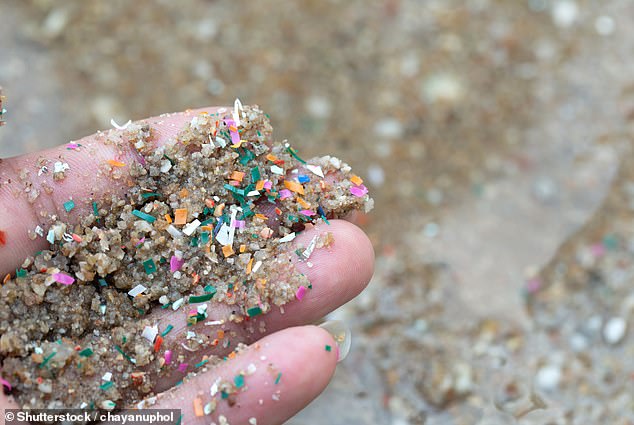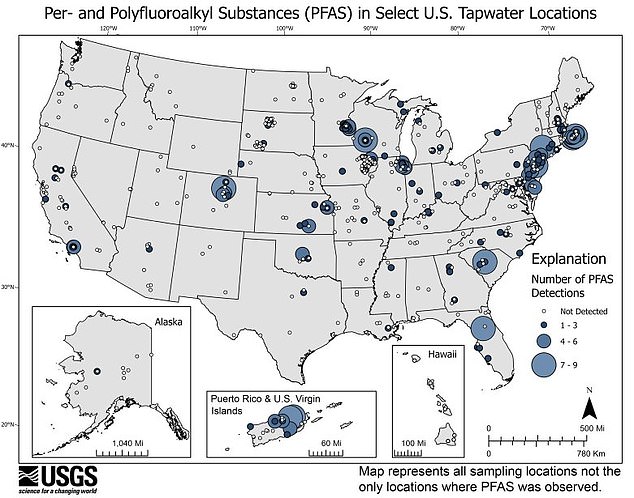Scientifically proven way ANYONE can remove 90% of toxic microplastics from their tap water within minutes
There’s a simple way to remove toxic chemicals from tap water using two common household items, according to a new study.
Researchers from Jinan University in China found that boiling water and then filtering it with a coffee filter removed almost 90 percent of tiny plastics linked to cancer and reproductive disorders.
These microplastics are so ubiquitous that they were found in 129 of the 159 tap water samples from 14 countries around the world in the study.
Boiling water was especially effective when used on ‘hard’ water, or water with high concentrations of minerals such as calcium and magnesium.
At high temperatures the limescale will solidify, effectively ‘caking’ the plastic particles and making them easy to remove through a filter.
Boiling water can trap nano- and microplastics in lime particles, which can then be easily filtered out

Over time, microplastics break down into nanoplastics, which are so small that they can enter the blood through our intestines and lungs and then travel through the body to organs such as the heart and brain.
The plastic particles contain phthalates – a group of chemicals used to make plastics more durable, flexible and last longer – which are known to disrupt hormone production in the body, which can increase the risk of reproductive disorders and cancer.
Phthalates are “linked to developmental, reproductive, brain, immune and other problems,” according to the National Institute of Environmental Health Sciences.
Nano and microplastics also carry toxins on their surfaces, such as heavy metals.
Over time, microplastics break down into nanoplastics, which are so small that they can enter the blood through our intestines and lungs and then travel through the body to organs such as the heart and brain.
Some advanced drinking water filtration systems capture nano- and microplastics, but simple, low-cost methods are needed to help substantially reduce human plastic consumption.
Reports show that plastic chemicals cause $249 billion in healthcare costs in the US in just one year.

The map compiled by the US Geological Survey shows the number of PFAS or “forever chemicals” detections at a large number of locations nationwide between 2016 and 2021.
The researchers wanted to see whether boiling could be an effective method to remove plastics from both hard and soft tap water.
Hard and soft water differ in the minerals they contain.
More particles could be removed from hard water than from soft water, because the microplastics get stuck in the lime particles, and hard water has more of them.
Soft water does not have high calcium and magnesium contents, but tends to have higher salt concentrations unless it has been softened with a potassium-based filtration system.
About 85 percent of U.S. water is classified as hard, but many homes and businesses use water softeners to remove minerals, softening the water.
The researchers collected samples of tap water from Guangzhou, China, and enriched them with different amounts of nano- and microplastics.
They found an average concentration of one milligram of nano- and microplastics per liter.
Samples were boiled for five minutes and allowed to cool. The team then measured the free-floating plastic content.
Boiling hard water, which is rich in minerals, will naturally form a chalky substance known as limescale or calcium carbonate.
“We estimate that the intake of nano- and microplastics through the consumption of boiled water was two to five times less than that through tap water on a daily basis,” says Zeng.
The results of these experiments indicated that as the water temperature increased, the limescale formed crusted substances, or crystalline structures, that enveloped the plastic particles.
Zeng says these crusty substances would build up over time like typical limescale, after which they can be scrubbed away to remove the nano- and microplastics.
He suggests that any remaining crusts floating in the water can be removed by pouring it through a simple filter such as a coffee filter.
In the tests, the encapsulation effect was more pronounced in harder water: in a sample containing 300 milligrams of limescale per liter of water, up to 90 percent of free-floating nano- and microplastics were removed after boiling.
But even in samples of soft water (less than 60 milligrams of limescale per liter), boiling still removed about 25 percent of nano- and microplastics.
The researchers say this work could provide a simple but effective method to reduce the consumption of nano- and microplastics.
The research was published in the journal ACS ‘Environmental Science and Technology Letters.
Exposure to phthalates is attributed to 100,000 premature deaths annually in the US.
